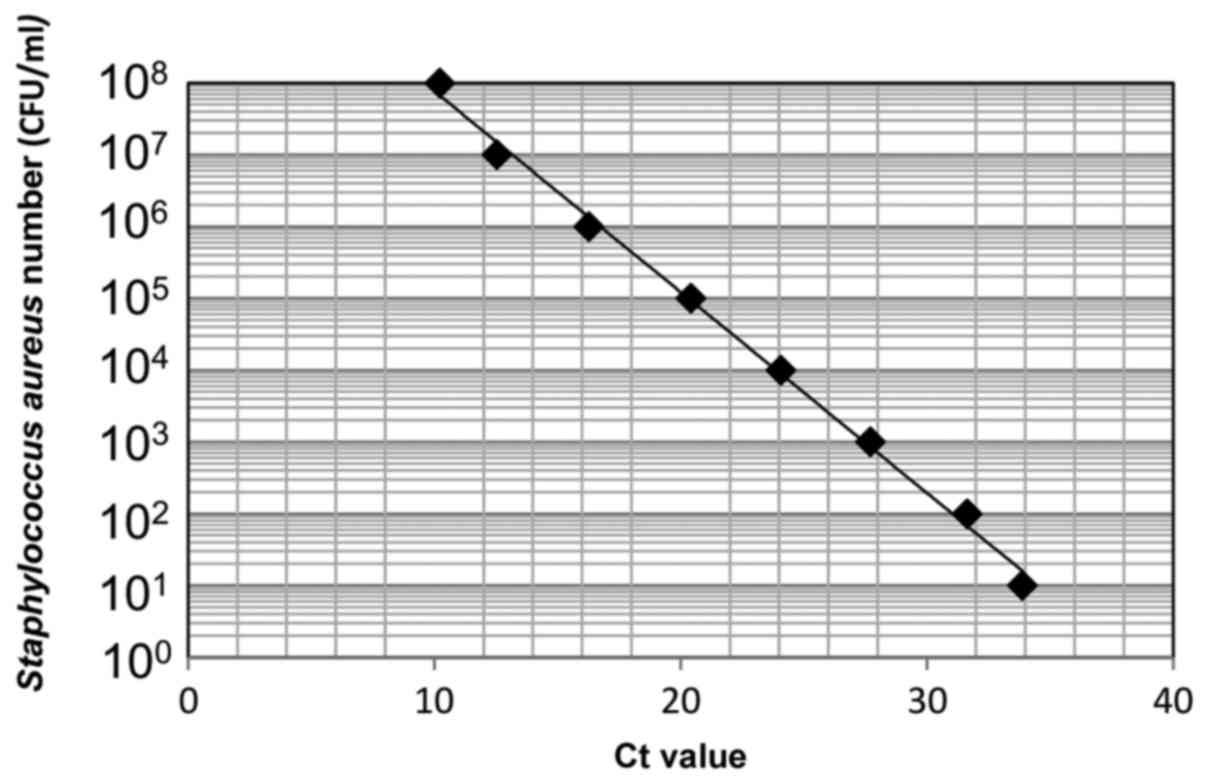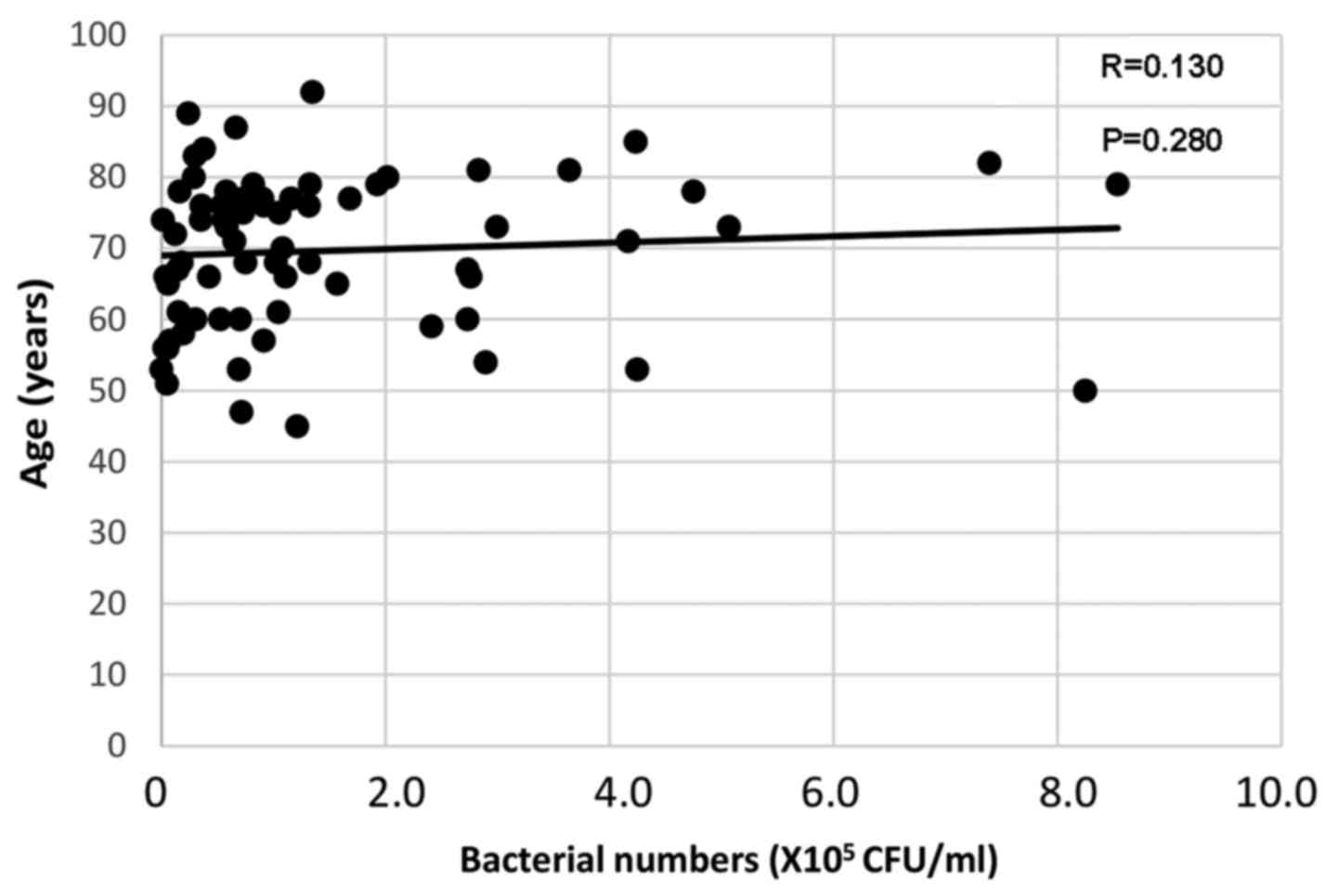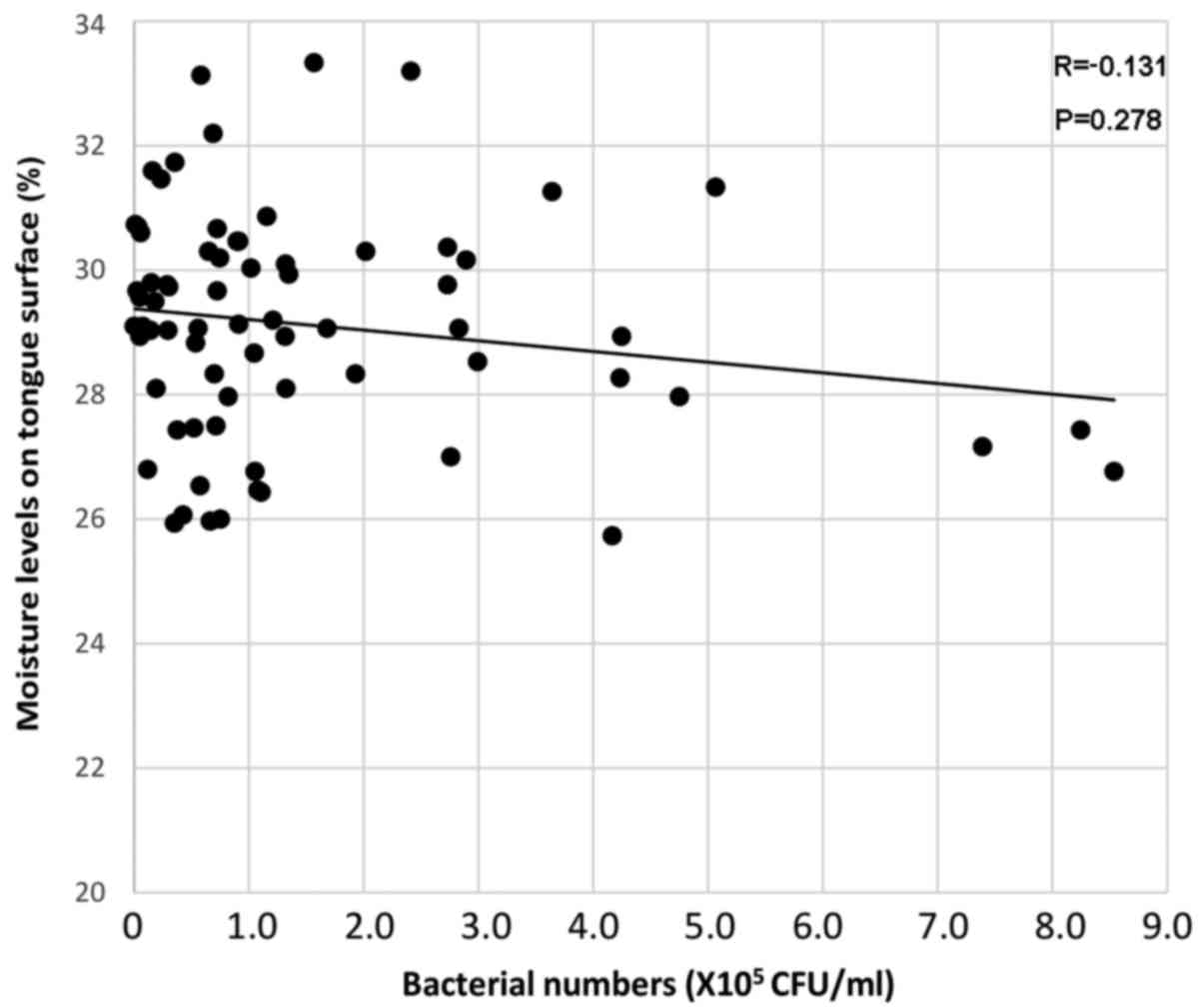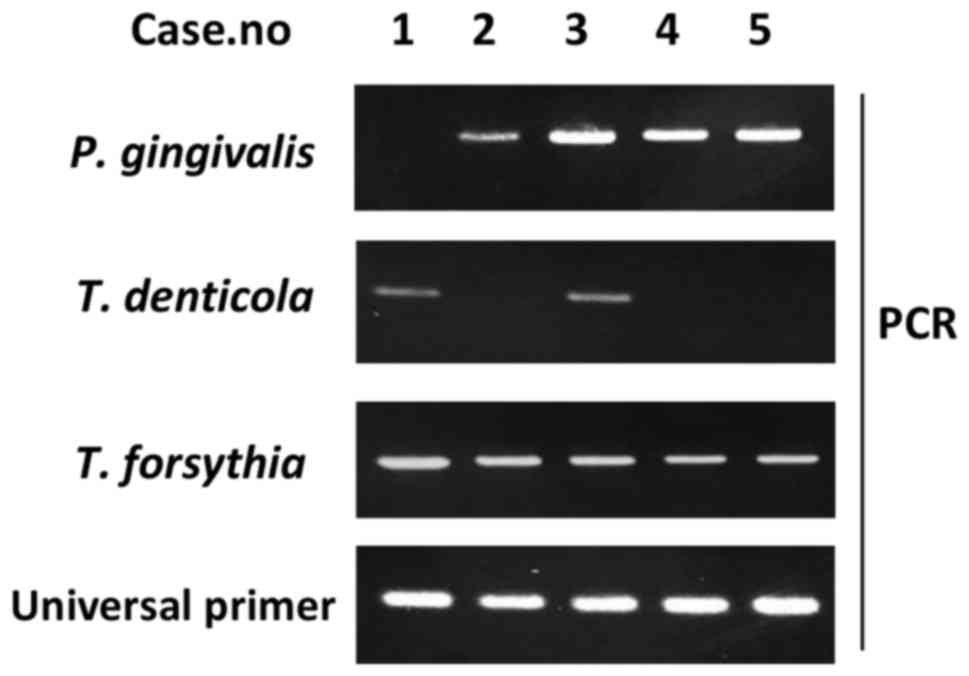|
1
|
Terpenning M: Geriatric oral health and
pneumonia risk. Clin Infect Dis. 40:1807–1810. 2005. View Article : Google Scholar : PubMed/NCBI
|
|
2
|
Shigeishi H, Ohta K, Fujimoto S, Nakagawa
T, Mizuta K, Ono S, Shimasue H, Ninomiya Y, Higashikawa K, Tada M,
et al: Preoperative oral health care reduces postoperative
inflammation and complications in oral cancer patients. Exp Ther
Med. 12:1922–1928. 2016. View Article : Google Scholar : PubMed/NCBI
|
|
3
|
Turner MD and Ship JA: Dry mouth and its
effects on the oral health of elderly people. J Am Dent Assoc.
138:15S–20S. 2007. View Article : Google Scholar : PubMed/NCBI
|
|
4
|
Kawano T, Shigeishi H, Fukada E,
Yanagisawa T, Kuroda N, Takemoto T and Sugiyama M: Changes in
bacterial number at different sites of oral cavity during
perioperative oral care management in gastrointestinal cancer
patients: Preliminary study. J Appl Oral Sci. 26:e201705162018.
View Article : Google Scholar : PubMed/NCBI
|
|
5
|
Hayashida S, Funahara M, Sekino M,
Yamaguchi N, Kosai K, Yanamoto S, Yanagihara K and Umeda M: The
effect of tooth brushing, irrigation, and topical tetracycline
administration on the reduction of oral bacteria in mechanically
ventilated patients: A preliminary study. BMC Oral Health.
16:672016. View Article : Google Scholar : PubMed/NCBI
|
|
6
|
Kobayashi K, Ryu M, Izumi S, Ueda T and
Sakurai K: Effect of oral cleaning using mouthwash and a mouth
moisturizing gel on bacterial number and moisture level of the
tongue surface of older adults requiring nursing care. Geriatr
Gerontol Int. 17:116–121. 2017. View Article : Google Scholar : PubMed/NCBI
|
|
7
|
Danser MM, Gómez SM and Van der Weijden
GA: Tongue coating and tongue brushing: A literature review. Int J
Dent Hyg. 1:151–158. 2003. View Article : Google Scholar : PubMed/NCBI
|
|
8
|
Segata N, Haake SK, Mannon P, Lemon KP,
Waldron L, Gevers D, Huttenhower C and Izard J: Composition of the
adult digestive tract bacterial microbiome based on seven mouth
surfaces, tonsils, throat and stool samples. Genome Biol.
13:R422012. View Article : Google Scholar : PubMed/NCBI
|
|
9
|
Horz HP, Vianna ME, Gomes BP and Conrads
G: Evaluation of universal probes and primer sets for assessing
total bacterial load in clinical samples: General implications and
practical use in endodontic antimicrobial therapy. J Clin
Microbiol. 43:5332–5337. 2005. View Article : Google Scholar : PubMed/NCBI
|
|
10
|
Suzuki N, Yoshida A and Nakano Y:
Quantitative analysis of multi-species oral biofilms by TaqMan
Real-Time PCR. Clin Med Res. 3:176–185. 2005. View Article : Google Scholar : PubMed/NCBI
|
|
11
|
Cutress TW, Ainamo J and Sardo-Infirri J:
The community periodontal index of treatment needs (CPITN)
procedure for population groups and individuals. Int Dent J.
37:222–233. 1987.PubMed/NCBI
|
|
12
|
Kembel SW, Wu M, Eisen JA and Green JL:
Incorporating 16S gene copy number information improves estimates
of microbial diversity and abundance. PLOS Comput Biol.
8:e10027432012. View Article : Google Scholar : PubMed/NCBI
|
|
13
|
Perisin M, Vetter M, Gilbert JA and
Bergelson J: 16Stimator: Statistical estimation of ribosomal gene
copy numbers from draft genome assemblies. ISME J. 10:1020–1024.
2016. View Article : Google Scholar : PubMed/NCBI
|
|
14
|
Yoshida A, Suzuki N, Nakano Y, Oho T,
Kawada M and Koga T: Development of a 5 fluorogenic nuclease-based
real-time PCR assay for quantitative detection of Actinobacillus
actinomycetemcomitans Porphyromonas gingivalis. J Clin
Microbiol. 41:863–866. 2003. View Article : Google Scholar : PubMed/NCBI
|
|
15
|
Livak KJ and Schmittgen TD: Analysis of
relative gene expression data using real-time quantitative PCR and
the 2(-Delta Delta C(T)) method. Methods. 25:402–408. 2001.
View Article : Google Scholar : PubMed/NCBI
|
|
16
|
Yasukawa T, Ohmori M and Sato S: The
relationship between physiologic halitosis and periodontopathic
bacteria of the tongue and gingival sulcus. Odontology. 98:44–51.
2010. View Article : Google Scholar : PubMed/NCBI
|
|
17
|
Takahashi F, Koji T and Morita O: Oral
dryness examinations: Use of an oral moisture checking device and
the usefulness of an oral moisture checking device and a modified
cotton method. Prosthodont Res Pract. 5:26–30. 2006. View Article : Google Scholar
|
|
18
|
Winkel EG, Roldán S, Van Winkelhoff AJ,
Herrera D and Sanz M: Clinical effects of a new mouthrinse
containing chlorhexidine, cetylpyridinium chloride and zinc-lactate
on oral halitosis. A dual-center, double-blind placebo-controlled
study. J Clin Periodontol. 30:300–306. 2003. View Article : Google Scholar : PubMed/NCBI
|
|
19
|
Socransky SS, Haffajee AD, Cugini MA,
Smith C and Kent RL Jr: Microbial complexes in subgingival plaque.
J Clin Periodontol. 25:134–144. 1998. View Article : Google Scholar : PubMed/NCBI
|
|
20
|
Veal DA, Deere D, Ferrari B, Piper J and
Attfield PV: Fluorescence staining and flow cytometry for
monitoring microbial cells. J Immunol Methods. 243:191–210. 2000.
View Article : Google Scholar : PubMed/NCBI
|
|
21
|
Socransky SS, Smith C, Martin L, Paster
BJ, Dewhirst FE and Levin AE: ‘Checkerboard’ DNA-DNA hybridization.
Biotechniques. 17:788–792. 1994.PubMed/NCBI
|
|
22
|
Hamada R, Suehiro J, Nakano M, Kikutani T
and Konishi K: Development of rapid oral bacteria detection
apparatus based on dielectrophoretic impedance measurement method.
IET Nanobiotechnol. 5:25–31. 2011. View Article : Google Scholar : PubMed/NCBI
|
|
23
|
Genco RJ and Borgnakke WS: Risk factors
for periodontal disease. Periodontol 2000. 62:59–94. 2013.
View Article : Google Scholar : PubMed/NCBI
|
|
24
|
Nishimura F, Iwamoto Y, Mineshiba J,
Shimizu A, Soga Y and Murayama Y: Periodontal disease and diabetes
mellitus: The role of tumor necrosis factor-alpha in a 2-way
relationship. J Periodontol. 74:97–102. 2003. View Article : Google Scholar : PubMed/NCBI
|
|
25
|
Chigasaki O, Takeuchi Y, Aoki A, Sasaki Y,
Mizutani K, Aoyama N, Ikeda Y, Gokyu M, Umeda M, Ishikawa I, et al:
A cross-sectional study on the periodontal status and prevalence of
red complex periodontal pathogens in a Japanese population. J Oral
Sci. 60:293–303. 2018. View Article : Google Scholar : PubMed/NCBI
|
|
26
|
Faveri M, Feres M, Shibli JA, Hayacibara
RF, Hayacibara MM and de Figueiredo LC: Microbiota of the dorsum of
the tongue after plaque accumulation: An experimental study in
humans. J Periodontol. 77:1539–1546. 2006. View Article : Google Scholar : PubMed/NCBI
|
|
27
|
Ford PJ, Gemmell E, Hamlet SM, Hasan A,
Walker PJ, West MJ, Cullinan MP and Seymour GJ: Cross-reactivity of
GroEL antibodies with human heat shock protein 60 and
quantification of pathogens in atherosclerosis. Oral Microbiol
Immunol. 20:296–302. 2005. View Article : Google Scholar : PubMed/NCBI
|
|
28
|
Seymour GJ, Ford PJ, Cullinan MP, Leishman
S and Yamazaki K: Relationship between periodontal infections and
systemic disease. Clin Microbiol Infect. 13 Suppl 4:3–10. 2007.
View Article : Google Scholar : PubMed/NCBI
|
|
29
|
Li H, Yang H, Ding Y, Aprecio R, Zhang W,
Wang Q and Li Y: Experimental periodontitis induced by
Porphyromonas gingivalis does not alter the onset or
severity of diabetes in mice. J Periodontal Res. 48:582–590. 2013.
View Article : Google Scholar : PubMed/NCBI
|
|
30
|
Meyer-Bäumer A, Eick S, Mertens C, Uhlmann
L, Hagenfeld D, Eickholz P, Kim TS and Cosgarea R: Periodontal
pathogens and associated factors in aggressive periodontitis:
Results 5-17 years after active periodontal therapy. J Clin
Periodontol. 41:662–672. 2014. View Article : Google Scholar : PubMed/NCBI
|


















